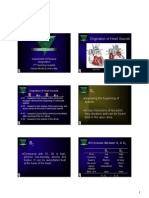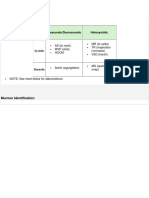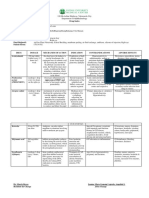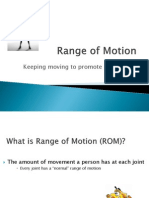0 ratings0% found this document useful (0 votes)
76 viewsD S2 - Diastolic Murmur - S1 Ms - Mitral Stenosis Ts - Tricuspid Stenosis Ar - Aortic Regurgitation
D S2 - Diastolic Murmur - S1 Ms - Mitral Stenosis Ts - Tricuspid Stenosis Ar - Aortic Regurgitation
Uploaded by
Miguel Cuevas DolotThis document provides information about various valvular heart diseases, including their associated murmurs, thrills, heart sounds, characteristics, clinical symptoms, and diagnosis. It describes mitral stenosis as having a diastolic rumbling murmur at the apex, with left atrial enlargement, elevated left atrial pressure gradient, and increased risk of pulmonary edema with tachycardia or atrial fibrillation. It also describes aortic regurgitation as having a diastolic decrescendo murmur along the left sternal border, with marked aortic dilatation and associated conditions like Marfan syndrome or ankylosing spondylitis. The document lists clinical features and complications of different valvular diseases.
Copyright:
© All Rights Reserved
Available Formats
Download as PDF, TXT or read online from Scribd
D S2 - Diastolic Murmur - S1 Ms - Mitral Stenosis Ts - Tricuspid Stenosis Ar - Aortic Regurgitation
D S2 - Diastolic Murmur - S1 Ms - Mitral Stenosis Ts - Tricuspid Stenosis Ar - Aortic Regurgitation
Uploaded by
Miguel Cuevas Dolot0 ratings0% found this document useful (0 votes)
76 views7 pagesThis document provides information about various valvular heart diseases, including their associated murmurs, thrills, heart sounds, characteristics, clinical symptoms, and diagnosis. It describes mitral stenosis as having a diastolic rumbling murmur at the apex, with left atrial enlargement, elevated left atrial pressure gradient, and increased risk of pulmonary edema with tachycardia or atrial fibrillation. It also describes aortic regurgitation as having a diastolic decrescendo murmur along the left sternal border, with marked aortic dilatation and associated conditions like Marfan syndrome or ankylosing spondylitis. The document lists clinical features and complications of different valvular diseases.
Original Description:
Internal Medicine
Original Title
cardio
Copyright
© © All Rights Reserved
Available Formats
PDF, TXT or read online from Scribd
Share this document
Did you find this document useful?
Is this content inappropriate?
This document provides information about various valvular heart diseases, including their associated murmurs, thrills, heart sounds, characteristics, clinical symptoms, and diagnosis. It describes mitral stenosis as having a diastolic rumbling murmur at the apex, with left atrial enlargement, elevated left atrial pressure gradient, and increased risk of pulmonary edema with tachycardia or atrial fibrillation. It also describes aortic regurgitation as having a diastolic decrescendo murmur along the left sternal border, with marked aortic dilatation and associated conditions like Marfan syndrome or ankylosing spondylitis. The document lists clinical features and complications of different valvular diseases.
Copyright:
© All Rights Reserved
Available Formats
Download as PDF, TXT or read online from Scribd
Download as pdf or txt
0 ratings0% found this document useful (0 votes)
76 views7 pagesD S2 - Diastolic Murmur - S1 Ms - Mitral Stenosis Ts - Tricuspid Stenosis Ar - Aortic Regurgitation
D S2 - Diastolic Murmur - S1 Ms - Mitral Stenosis Ts - Tricuspid Stenosis Ar - Aortic Regurgitation
Uploaded by
Miguel Cuevas DolotThis document provides information about various valvular heart diseases, including their associated murmurs, thrills, heart sounds, characteristics, clinical symptoms, and diagnosis. It describes mitral stenosis as having a diastolic rumbling murmur at the apex, with left atrial enlargement, elevated left atrial pressure gradient, and increased risk of pulmonary edema with tachycardia or atrial fibrillation. It also describes aortic regurgitation as having a diastolic decrescendo murmur along the left sternal border, with marked aortic dilatation and associated conditions like Marfan syndrome or ankylosing spondylitis. The document lists clinical features and complications of different valvular diseases.
Copyright:
© All Rights Reserved
Available Formats
Download as PDF, TXT or read online from Scribd
Download as pdf or txt
You are on page 1of 7
VALVULAR HEART DISEASES (Diastolic Murmurs) – CODE: DARTS; S2 – diastolic murmur – S1
MS – MITRAL STENOSIS TS – TRICUSPID STENOSIS AR – AORTIC REGURGITATION
MURMUR Diastolic rumbling at apex Diastolic murmur at left lower Diastolic decrescendo murmur
sternal border; prominent during heard best at 3rd ICS along the
presystole in sinus rhythm; left sternal border
augmented in inspiration; reduced If soft – best heard by diaphragm
during expiration and valsalva leaning forward
maneuver High pitched, blowing radiating
to axilla (CODE: ARA)
Austin flint murmur- soft low
pitched rumbling mid-diastolic
murmur
HEAVES/ Diastolic thrill at apex; px in left LV heaves displaced laterally and
THRILLS lateral recumbent position inferiorly
Diastolic thrill at L sternal border
Systolic thrill at suprasternal
notch
Carotid atrial pulse is bisferiens
OTHERS Opening snap heard at expiration at Traube’s sign over femoral
HEART apex; Loud S1 arteries
SOUNDS S2 closely split Duroziez’ s sign at femoral art. –
Loud P2 (parasternal lift) to-and-fro murmur
Absent A2
(+) S3; occasional S4
CHAR. LAE/ AF (thrombi arise particularly RAE – tall p waves lead II and V1 Marked aortic dilatation; aortic
FEATURES at the LA appendage). root disease;
RVH Assoc. with Marfan syndrome,
RAE – RV tap at L sternal border VSD, ankylosing spondylitis
Fish-mouth valve Widened aortic annulus and
separated aortic leaflets
LV entire SV is ejected into aorta
Inc. preload or EDV is the major
hemodynamic compensation for
AR
Jarring of body and bobbing of
head with each systole
Uncomfortable awareness of
heartbeat
MS – MITRAL STENOSIS TS – TRICUSPID STENOSIS AR – AORTIC REGURGITATION
CLINICAL L sided HF Systemic venous congestion, ACUTE SEVERE AR
SYMPTOMS R sided HF hepatomegaly, ascites, edema - Infective endocarditis, aortic
Hemoptysis Pulmonary congestion initially dissection, trauma, LV cannot
Systemic embolization Fatigue and discomfort; little dilate to maintain SV; Pulmo
Hoarseness dyspnea edema and cardio shock may
Chest pain R sided HF deveop rapidly
Palpitation If severe = hepatic congestion, CHRONIC SEVERE AR
Malar flush with pinched blue facies cirrhosis, jaundice, malnutrition, - Asymptomatic for 10-15 yrs,
anasarca, ascites uncomfortable awareness of
heartbeat, sinus tachycardia,
PVC,
- Dyspnea – first symptom of
dec. cardiac reserve
- Orthopnea, PND, diaphoresis,
chest pain
- Congestive hepatomegaly,
ankle edema - late
Assoc. lesions Carvallo’s sign (pansystolic murmur Annulo-aortic ectasia
together with TR) Osteogenesis imperfect
Graham Steell murmur of PR Severe HPN
Syphilis and a. spondylitis
Myocardial ischemia
Corrigan’s pulse – water hammer
pulse
Quincke’ s pulse
Dx 2D echo: thick MV leaflets, reduced 2D: TV is thick and domes in diatole
valve orifice
book LV symptoms but without LV Rheumatic in origin; more common to Rheumatic in origin; may result
dysfunction; females; from infective endocarditis
Caused by RF; Augmented diastolic pressure
Elevated LAV pressure gradient gradient bet. RA and RV
– hallmark of MS Tall a wave and prolonged y descent
Inc. HR shortens diastole
= tachycardia + AF +inc LA
pressure = pulmo edema and
hemoptysis
Inc. LA and PA wedge pressure
= atrial contraction (a wave) and
gradual pressure decline (y descent)
VALVULAR HEART DISEASES (Systolic Murmurs) – CODE: SAPS; S1 – systolic murmur – S2
MR- Mitral Regurgitation TR- Tricuspid Regurgitation AS- Aortic Stenosis
MURMUR Apical systolic murmur Blowing Holosystolic murmur at L Mid-systolic ejection murmur at
Grade III/VI, holosystolic sternal border the base after S1
Radiates to axilla Inc. with inspiration and dec. with Low pitched rough rasping
+isometric exercise valsava and expiration loudest at the base of the heart in
- Valsava (CARVALLO’s sign) the 2nd ICS radiating to carotid
Acute MR is decrescendo arteries (CODE: CAS)
Chronic MR plateau Sometimes at the apex or
GALLAVARDIN EFFECT
Grade III/VI
HEAVES/ LV heave RV pulsations at L parasternal systolic thrill at the base of the
THRILLS Systolic thrill at apex heart
Palpable S3 LV impulse displaced laterally
Displaced apex beat laterally
(chronic) in acute not displaced
OTHERS Soft S1 or absent Paradoxic splitting of S2
HEART Wide splitting of S2 S4 is audible at the apex reflects
SOUNDS Low pitched S3 LV hypertrophy
S4 often audible
Sea gull quality in ruptured tendinae
CHAR. LVH, LAE, RAR, RVE Prominent v wave and rapid y Carotid upstroke delayed,
FEATURES Associated with MVP and HOCM descent peripheral pulses rises slowly to a
LV afterload reduced Prominent c-v wave delayed sustained peak (PULSUS
EF rises in severe MR RV enlargement, inf. Wall infarcts PARVUS et TENDUS)
Atrial pulse show sharp upstroke RA enlargement Double apical impulse
Reversible if pulmonary HPN is Obstruction of LV outflow
relieved
SYMPTOMS Dyspnea, orthopnea Edema, ascites, Jaundice, neck vein 3 cardinal symptoms:
Pulmonary edema distention (R sided) Angina pectoris
Palpitation – start of AF Hepatomegaly, pleural eff, systolic Exertional dyspnea
R sided HF pulsations of liver, hepatojugular syncope
reflux CHF – L sided in severe AS
Systemic venous congestion
Reduction of CO
Dx TTE and Doppler imaging Color flow Doppler echo Doppler – focal thickening or
LV EDV-ESV, and EF calcif of valve cusps
XRAY- calcification, kerley B lines LVH, ST segment depression and
T wave inversion or LV strain
book Involve 1 or 5 functional components Functional TR and secondary to Males, chronic valvular heart
of mitral valve dilatation of tricuspid annulus Due to degenerative calcification
Papillary muscle rupture, chordae Associated with Ebstein of aortic cusps
tendinae muscle group malformation Age-degenerative calcific AS or
Caused by RHD senile or sclerocalcific AS – most
Males commonly common cause
may occur as atrioventricular Atherosclerosis and vascular
cushion defects inflammation
rapid y descent Bicuspid aortic valve (BAV)
regurgitant vol.= more 6oml/beat
v wave prominent in LA pressure if
acute MR, if chronic vice versa
Treatment Warfarin once AF Isolated TR – operation not ACE, bblocker, nitrolgycerine,
Cardioversion required statins
ACE, Bblockers, diuretics, digitalis Tricuspid annuloplasty, tricuspid Operations
Valvuloplasty, annuloplasty ring valve replacement Aortic root reconstruction,
In AF- left atrial Maze procedure or coronary bypass,
radiofrequency ablation Percutaneous balloon aortic
valvuloplasty
MVP – Mitral valve Prolapse
MURMUR Systolic click murmur syndrome, Earlier click (dec. LV vol.)
Barlow’s syndrome, floppy valve Standing
syndrome, billowing mitral leaflet Valsava
syndrome Amyl nitrate inhalation
Mid or late systolic click Delayed click (inc LV vol.)
Followed by high pitched, late Squatting
systolic crescendo-decrescendo isometrics
murmur
Whooping or honking best heard at
the apex
DYNAMIC AUSCULTATION
HEAVES/
THRILLS
OTHERS
HEART
SOUNDS
CHAR. Excessive mitral leaflet tissue
FEATURES Myxomatous degeneration
Inc. acid mucopolysaccharide
Associated with Marfan syndrome,
osteogenesis imperfect, Ehler-
Danlos sysndrome, thoracic skeletal
deformities, straight back syndrome
SYMPTOMS PVC’s, Vtach, paroxysmal
supraventricular
Palpitations, light-headedness and
syncope
Transient cerebral ischemic attacks
Dx ECG – inverted T waves leads II, III
aVF
Doppler, TTE
book Genetically determined collagen
disorder
Dec. collagen type 3
Females age 15-30; often benign
Also males of 50 yo
Treatment Infective endocarditis prophylaxis
Bblockers, aspirin, warfarin
Mitral valve repa
CONGENITAL HEART DISEASES – L-to-R SHUNT - acyanotic
ASD – Atrial Septal Defect VSD – Ventricular Septal Defect PDA – Patent Ductus Arteriosus
MURMUR Mid-diastolic rumbling murmur loudest Murmur appearing after birth Thrill and continuous MACHINERY
at the 4th ICS and along L sternal border Holosystolic murmur on the L sternal murmur (below L clavicle –
border radiating rightward hallmark)
Late systolic accentuation at the L
sternal edge
THRILL Apical thrill and holosystolic murmur in Systolic thrill at the L sternal border
ostium primum defects
OTHERS Split or normal S1 Loud P2 Bounding pulses and widened pulse
HEART Accentuated tricuspid valve closure + S3 pressure
SOUNDS Widely split S2 fixed in respiration
CHAR. Diastolic overloading of RV and inc. Not a R sided murmur EISENMENGER Syndrome
FEATURES pulmo BF + CARVALLO’S SIGN DIFFERENTIAL CYANOSIS – toes
Prominent RV impulse and palpable LVE, LAE become cyanotic and clubbed
pulmonary artery pulsation Cannot appreciate RA because it is LVH
LUTENBACHER SYNDROME = ASD + posteriorly located
MS
SYMPTOMS AF, respi inf., cardio symptoms, PAH, Pulmo HPN, R-L shunting cyanosis
bidirectional then R-L shunting of blood will eventually develop
then HF HF, infective endocarditis – leading
cause of death
Dx ECG ostium secundum – R axis 2D echo - LVE
deviation and an rSr’ pattern;
1st degree HB in sinus venous type
Ostium primum – L axis deviation
ECHO- RV and RA dilatation
book Common in females
Sinus Venosus – high in atrial septum
near SVC into RA; assoc. with
anomalous pulmo venous connection
from R lung to SVC or RA
Ostium Primum – adjacent to AV valves
deformed or regurgitant; common in
Down’s syndrome
Ostium Secundum – involves fossa ovalis
and midseptal location; probe patency, a
true deficiency of the atrial septum and
implies functional and anatomic patency
Treatment Repair with patch of pericardium or Surgical ligation or dividision
prosthetic material, or percutaneous Coils, buttons, plugs, umbrellas
transcatheter device closure
Tx of respi symptoms, AF, HF
CONGENITAL HEART DISEASES – COMPLEX CONGENITAL HEART LESION -
ACYANOTIC WITHOUT A SHUNT TETRALOGY OF FALLOT
COARTATION OF THE AORTA TETRALOGY OF FALLOT
MURMUR Mid-systolic murmur over the L interscapular MURMUR Murmur of pulmonic stenosis
space Absent P2
Additional systolic and continuous murmurs
over the lateral thoracic wall
THRILL THRILL
OTHERS OTHERS
HEART HEART
SOUNDS SOUNDS
CHAR. Narrowing of the lumen of the aorta distal to CHAR. Most common cyanotic heart disease in adults
FEATURES the origin of L subclavian artery near FEATURES History of exercise intolerance and squatting
ligamentum arteriosum Pulmonary stenosis overriding the aorta
Bicuspid aortic valve
Circle of Willis aneurysms
SYMPTOMS Headache, epistaxis, cold extremities, SYMPTOMS Severe cyanosis
claudication with exercise Severe erythrocytosis
Systemic hypoxemia
Dx LVH Dx ECG – RV hypertrophy
Dilated subclavian artery X-ray – BOOT-SHAPED HEART or COEUR EN
3 sign SABOT
Notching of the 3rd and 9th ribs
book More in males book FOUR COMPONENTS OF TOF
More in px with gonadal dysgenesis or Malaligned VSD,
TURNER’S syndrome Obstruction to RV outflow,
Enlarged pulsatile collateral vessels may be Aortic override of VSD and
palpated in the ICS, axialle RV hypertrophy due to RV “seeing” aortic
pressure via the large VSD
Pulmonary blood flow is reduced markedly
Treatment Surgical Treatment Angioplasty
Percutaneous catheter ballon with stent Stenting of branch pulmonary stenosis
dilatation
Zetmontemayor 09’11
You might also like
- Drug Study MetoclopramideDocument2 pagesDrug Study Metoclopramiderica sebabillones100% (2)
- HEART MURMURS by NISHDocument41 pagesHEART MURMURS by NISHurtikikeNo ratings yet
- Word Association PANCEDocument31 pagesWord Association PANCEnevmerka100% (1)
- Clinical Medicine Cheat Sheet Ebook PDFDocument18 pagesClinical Medicine Cheat Sheet Ebook PDFMoka100% (1)
- Encephalopathy in Children: An Approach To Assessment and ManagementDocument8 pagesEncephalopathy in Children: An Approach To Assessment and ManagementLiaw Siew Ching 廖秀清No ratings yet
- Heartsound MurmurDocument2 pagesHeartsound MurmurDya AndryanNo ratings yet
- Heart SoundsDocument2 pagesHeart Soundsdanny_awwadNo ratings yet
- Cardiac Examination Inspection, Palpation & Percussion : Dr. Rajesh Bhat UDocument38 pagesCardiac Examination Inspection, Palpation & Percussion : Dr. Rajesh Bhat URanjith RavellaNo ratings yet
- Mumurs Summary PDFDocument6 pagesMumurs Summary PDFykteo323No ratings yet
- CVS Heart MurmursDocument2 pagesCVS Heart MurmursIamTinesh100% (1)
- INTRO CARDIOLOGY LECTURE FinalDocument38 pagesINTRO CARDIOLOGY LECTURE FinalFlorencio D. Santos IVNo ratings yet
- Count To Ten Allowing YourselfDocument1 pageCount To Ten Allowing YourselfwisgeorgekwokNo ratings yet
- Common Valvular Heart Disease (At A Glance)Document1 pageCommon Valvular Heart Disease (At A Glance)Tamim IshtiaqueNo ratings yet
- IM Boards RefresherDocument531 pagesIM Boards RefresherAlyssandra LucenoNo ratings yet
- Assessing Heart and Neck Vessel Heart Heart Chambers: (Tricuspid & Bicuspid)Document7 pagesAssessing Heart and Neck Vessel Heart Heart Chambers: (Tricuspid & Bicuspid)Dan Floyd FernandezNo ratings yet
- CVS Questions Vivek SirDocument4 pagesCVS Questions Vivek Sirmdrnh6shbmNo ratings yet
- Origination of Heart Sounds: Department of Physical Diagnostics 1 Teaching Hospital Henan Medical UniversityDocument6 pagesOrigination of Heart Sounds: Department of Physical Diagnostics 1 Teaching Hospital Henan Medical Universityapi-19916399No ratings yet
- First Aid CVS - AnatomyDocument1 pageFirst Aid CVS - AnatomyMohammed HalimyNo ratings yet
- Cardiology CardiovascularExaminationDocument5 pagesCardiology CardiovascularExaminationSalifyanji SimpambaNo ratings yet
- CardiologyDocument149 pagesCardiologyMuhammad SyafiqNo ratings yet
- Valvular Heart DiseaseDocument6 pagesValvular Heart DiseaseShafiq ZahariNo ratings yet
- CardiovaskularDocument9 pagesCardiovaskularUnggul YudhaNo ratings yet
- Congenital Heart DiseasesDocument1 pageCongenital Heart DiseasesEmily AnnNo ratings yet
- Cardiovascular System DDocument19 pagesCardiovascular System DVarun B RenukappaNo ratings yet
- Approach To Chest Pain 1Document5 pagesApproach To Chest Pain 1Sonu CanNo ratings yet
- Murmurs PDFDocument1 pageMurmurs PDFnot here 2make friends sorryNo ratings yet
- Coronary Artery DiseaseDocument3 pagesCoronary Artery DiseaseRitz CelsoNo ratings yet
- Clinical DiseasesDocument3 pagesClinical DiseasesSeung Chan YooNo ratings yet
- Approach To ArrhythmiasDocument1 pageApproach To ArrhythmiasADITYA SARANGINo ratings yet
- Clinical MedicineDocument18 pagesClinical MedicineRishikesh AsthanaNo ratings yet
- Right + Increased Vascularity + Fixed S2 / Widely Split Austin-Flint (Chronic) Graham Steele MurmurDocument14 pagesRight + Increased Vascularity + Fixed S2 / Widely Split Austin-Flint (Chronic) Graham Steele MurmurRojales FrancisNo ratings yet
- 10 - Aortic Diseases (Illustrations Key)Document2 pages10 - Aortic Diseases (Illustrations Key)Asingwire BelindaNo ratings yet
- Valvular Heart Disease: Vincent E. Friedewald, M.DDocument69 pagesValvular Heart Disease: Vincent E. Friedewald, M.DAnthie FitriNo ratings yet
- MurmursDocument3 pagesMurmursSijo SunnyNo ratings yet
- Aortic and Pulmonary Valve DiseaseDocument2 pagesAortic and Pulmonary Valve DiseaseKaja MatovinovicNo ratings yet
- REVIEWER2Document6 pagesREVIEWER2Lorielyn Ashlee GaiteNo ratings yet
- Valvular HDsDocument2 pagesValvular HDsBell GatesNo ratings yet
- PANCE Word Associations PDFDocument27 pagesPANCE Word Associations PDFkatNo ratings yet
- ECG Normal Values and InterpretationsDocument6 pagesECG Normal Values and InterpretationsAlexandryaHaleNo ratings yet
- Characteristics of Valvular Murmurs: 2023 Edition 3Document1 pageCharacteristics of Valvular Murmurs: 2023 Edition 3Mike GNo ratings yet
- Kev's Guide To Physical ExaminationDocument16 pagesKev's Guide To Physical ExaminationBogdan PetrescuNo ratings yet
- Heart SoundDocument29 pagesHeart Sounddianpratiwirahim100% (1)
- MRCP Paces ZM FinalDocument67 pagesMRCP Paces ZM FinalFarrukh AslamNo ratings yet
- Diastolic MurmursDocument2 pagesDiastolic MurmursnwtbsjjvmyNo ratings yet
- Acyanotic Congenital Heart DiseasesDocument7 pagesAcyanotic Congenital Heart DiseasesAlvin De LunaNo ratings yet
- CardiovascularDocument2 pagesCardiovascularJoão Pedro JacinthoNo ratings yet
- Hendra - EKGDocument34 pagesHendra - EKGRINANo ratings yet
- Mitral Valve ProlapseDocument2 pagesMitral Valve ProlapseAyumi StarNo ratings yet
- CT - L22 - Congenital Heart DiseaseDocument5 pagesCT - L22 - Congenital Heart Disease014 Reshaina ZahratuljannahNo ratings yet
- Cardio ReviewDocument25 pagesCardio ReviewHarini PrayagaNo ratings yet
- Examination of The Cardiovascular SystemDocument2 pagesExamination of The Cardiovascular Systemkenners98% (44)
- Congestive Heart FailureDocument1 pageCongestive Heart FailureAmardeep DebbarmaNo ratings yet
- Valvular Heart Disease: Chalinee Pravarnpat, M.DDocument49 pagesValvular Heart Disease: Chalinee Pravarnpat, M.DChalee InkateNo ratings yet
- Cardiac MurmursDocument3 pagesCardiac MurmursDanielleNo ratings yet
- Cvs ExaminationDocument3 pagesCvs ExaminationAldrin CastellinoNo ratings yet
- CARDIAC TUMORS TransDocument12 pagesCARDIAC TUMORS TransjeccomNo ratings yet
- Right To Left Shunts TableDocument5 pagesRight To Left Shunts TableIgwe SolomonNo ratings yet
- Valvular Heart DiseaseDocument4 pagesValvular Heart DiseaseAfif Al BaalbakiNo ratings yet
- Peds Shelf NotesDocument73 pagesPeds Shelf NotesTanyaMusonza100% (1)
- EKG Interpretation Basics Guide: Electrocardiogram Heart Rate Determination, Arrhythmia, Cardiac Dysrhythmia, Heart Block Causes, Symptoms, Identification and Medical Treatment Nursing HandbookFrom EverandEKG Interpretation Basics Guide: Electrocardiogram Heart Rate Determination, Arrhythmia, Cardiac Dysrhythmia, Heart Block Causes, Symptoms, Identification and Medical Treatment Nursing HandbookNo ratings yet
- Physical Examination in ENT: Ussana Promyothin, MDDocument60 pagesPhysical Examination in ENT: Ussana Promyothin, MDMiguel Cuevas DolotNo ratings yet
- PSB 368Document6 pagesPSB 368Miguel Cuevas DolotNo ratings yet
- Effectiveness of Transdermal MagnesiumDocument2 pagesEffectiveness of Transdermal MagnesiumMiguel Cuevas Dolot100% (1)
- Physical Assessment: Ear, Nose, Mouth, and ThroatDocument59 pagesPhysical Assessment: Ear, Nose, Mouth, and ThroatMiguel Cuevas DolotNo ratings yet
- Covid 19 PDFDocument18 pagesCovid 19 PDFMiguel Cuevas DolotNo ratings yet
- Drug IndexDocument2 pagesDrug IndexMiguel Cuevas DolotNo ratings yet
- Active Listening HANDOUT PDFDocument26 pagesActive Listening HANDOUT PDFMiguel Cuevas DolotNo ratings yet
- HEMAreviewDocument3 pagesHEMAreviewMiguel Cuevas DolotNo ratings yet
- Anesthesia Pocket Cards 7 18 18Document6 pagesAnesthesia Pocket Cards 7 18 18Miguel Cuevas DolotNo ratings yet
- Intern App PediatricsDocument36 pagesIntern App PediatricsMiguel Cuevas Dolot100% (2)
- Anesthesia Pocket Cards 7 18 18Document6 pagesAnesthesia Pocket Cards 7 18 18Miguel Cuevas DolotNo ratings yet
- Allergic Bronchopulmonary Aspergillosis: PathophysiologyDocument8 pagesAllergic Bronchopulmonary Aspergillosis: PathophysiologySyed Ali AkbarNo ratings yet
- Pych Preboards QuestionsDocument18 pagesPych Preboards QuestionsPaul Lexus Gomez LorenzoNo ratings yet
- Sección 8 Radiología Pediátrica: Preguntas Con Opciones de Respuestas Múltiples para Especialistas en RadiodiagnósticoDocument37 pagesSección 8 Radiología Pediátrica: Preguntas Con Opciones de Respuestas Múltiples para Especialistas en RadiodiagnósticoAlba NavalonNo ratings yet
- Degenerative Disorders of The Spine: NeuroDocument8 pagesDegenerative Disorders of The Spine: NeuroAhmad SyahmiNo ratings yet
- Cerebellar ExaminationDocument5 pagesCerebellar ExaminationRie Aoyama-Wang100% (1)
- Nose sCleRomaDocument23 pagesNose sCleRomaalhassanmohamedNo ratings yet
- Batce Road Run Results 25th Mar 2017Document2 pagesBatce Road Run Results 25th Mar 2017api-295233031No ratings yet
- Labreportnew Aspx PDFDocument2 pagesLabreportnew Aspx PDFmanali bhardwajNo ratings yet
- ADC W2016 Damir TanyaDocument50 pagesADC W2016 Damir TanyaThamadapu Swathi100% (1)
- Ent Midterms SamplexDocument7 pagesEnt Midterms SamplexdeevoncNo ratings yet
- HemoptysisDocument4 pagesHemoptysisBlack DragonNo ratings yet
- Formatif NBSSDocument17 pagesFormatif NBSSCYNTHIA ARISTANo ratings yet
- Arterio-Venous MalformationsDocument59 pagesArterio-Venous MalformationsAnil Kumar ReddyNo ratings yet
- Gastroesophageal Reflux Disease - RepairedDocument40 pagesGastroesophageal Reflux Disease - RepairedSowndharyaNo ratings yet
- Antipsycotic DrugDocument21 pagesAntipsycotic DrugShashank SatheNo ratings yet
- Pediatrics CLINICAL QUESTIONDocument14 pagesPediatrics CLINICAL QUESTIONAyesha KhatunNo ratings yet
- IA1 - Patho TheoryDocument4 pagesIA1 - Patho TheoryAshish GhoshNo ratings yet
- AsphyxiaDocument20 pagesAsphyxiaTrishenth FonsekaNo ratings yet
- Review of Pathology and Genetic - Gobind Rai GargDocument1,511 pagesReview of Pathology and Genetic - Gobind Rai GargJocelyn Ceja100% (1)
- Alterations in Oxygenation 2Document18 pagesAlterations in Oxygenation 2alejandrino_leoaugustoNo ratings yet
- Intl ACGVGRAhn Liver LesionDocument39 pagesIntl ACGVGRAhn Liver LesionheyheyokayNo ratings yet
- Range of Motion PresentationDocument27 pagesRange of Motion Presentationsathish100% (1)
- EBCPG-diagnosis and Initial Management of Cervical Lymphadenopathy PDFDocument15 pagesEBCPG-diagnosis and Initial Management of Cervical Lymphadenopathy PDFPhilippe Ceasar C. BascoNo ratings yet
- Nursing Interventions and Rationales - Impaired Skin IntegrityDocument11 pagesNursing Interventions and Rationales - Impaired Skin IntegrityJOSHUA DICHOSONo ratings yet
- Nursing Care PlanDocument2 pagesNursing Care Planusama_salaymehNo ratings yet
- Cooper 1982Document5 pagesCooper 1982Nadine ShabrinaNo ratings yet
- Diabetic Emergencies and ManagementDocument41 pagesDiabetic Emergencies and ManagementNali peterNo ratings yet
- Lesson1 - Measles. Rubella. Chicken Pox. Herpes Zoster. Scarlet Fever. PseudotuberculosisDocument84 pagesLesson1 - Measles. Rubella. Chicken Pox. Herpes Zoster. Scarlet Fever. PseudotuberculosisDeep SleepNo ratings yet



































































































